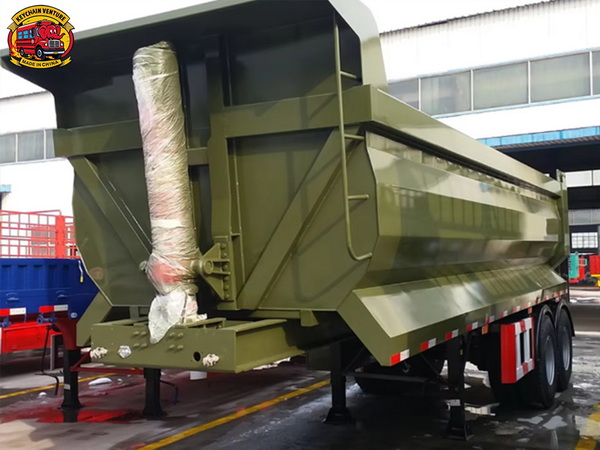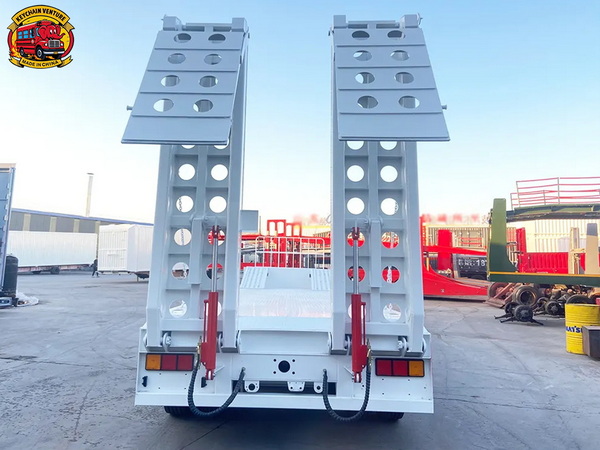Views: 222 Author: Amanda Publish Time: 2025-10-10 Origin: Site








Content Menu
● What Is a Semi Trailer Hitch?
● Main Components of a Semi Trailer Hitch
>> Kingpin
>> Locking Mechanism and Safety Features
>> Landing Gear
● How Does a Semi Trailer Hitch Work?
● Step-by-Step Semi Trailer Hitching Procedure
● Safety Mechanisms in Semi Trailer Hitches
● Comparison with Other Trailer Hitches
● Technical Specifications of Semi Trailer Hitches
● FAQ
>> 1. What role does the kingpin play in a semi trailer hitch?
>> 2. How is the trailer securely fastened to the tractor?
>> 3. Why is lubrication critical for the semi trailer hitch?
>> 4. What safety features protect against unintended uncoupling?
>> 5. How frequently should semi trailer hitch parts be checked?
The semi trailer hitch is a crucial technology in commercial freight transport, providing the connection between a tractor unit and the semi trailer it pulls. This hitch system, distinct from conventional trailer hitches, is designed to manage the immense weight and dynamic forces involved in hauling heavy loads safely and efficiently. As a leading Chinese supplier of high-performance buses and heavy trucks, KeyChain Venture Co., Ltd.recognizes the importance of understanding the semi trailerhitch mechanism, which plays a fundamental role in the reliable operation of commercial vehicles.

This article explores the technical structure, working principle, safety features, and maintenance of the semi trailer hitch, with a focus on the fifth wheel connection system. It explains the hitching and unhitching process clearly and provides practical insights for operators and fleet managers.
A semi trailer hitch is a specialized coupling device used mainly in commercial trucking. It connects a semi trailer—a large trailer designed to carry freight without its own front axle—to a tractor or truck. Unlike light vehicle ball hitches, the semi trailer hitch utilizes a robust fifth wheel coupling system capable of handling extremely heavy loads and allowing articulated movement between the tractor and trailer.
In an operational setting, the hitch must allow the trailer to pivot smoothly during turns while securely bearing the trailer's vertical and horizontal loads. This functionality is critical for the safety of both the vehicle operators and other road users.
The kingpin is a thick, cylindrical steel pin located underneath the front of the semi trailer. Serving as the main locking point, it inserts into the fifth wheel plate on the truck. The kingpin carries the trailer's weight down through the fifth wheel, enabling a strong, load-bearing connection while permitting rotation.
The fifth wheel hitch is a large, flat, horseshoe-shaped metal plate mounted securely on the tractor's frame. This plate has an opening mechanism to receive and lock around the kingpin. It is designed to distribute the trailer's weight between the tractor's axles for stability. The fifth wheel assembly also enables horizontal and vertical pivoting, critical for steering and absorbing vibrations.
When a trailer's kingpin slides into the fifth wheel, locking jaws on the fifth wheel plate close around it, securing the connection with a firm grip. Additional safety features include:
- Safety clips or locking pins that prevent accidental jaw release.
- Emergency brake connections that activate if the trailer becomes detached.
- Electrical hookups that maintain trailer lights and ABS brake systems.
The landing gear supports the trailer when it is not connected to the tractor. These retractable legs can be lowered or raised using manual cranks or automated controls. The landing gear must be properly adjusted during the hitching process to align the trailer height with the tractor.
The semi trailer hitch functions by mating the kingpin located on the semi trailer to the fifth wheel hitch on the tractor. The process begins by positioning the tractor to back underneath the trailer, aligning the fifth wheel opening with the kingpin. As the tractor reverses forward, the kingpin slides into the fifth wheel jaws, triggering the locking mechanism to securely clamp around the pin. This clamping action prevents separation of the trailer during transit.
This coupling creates a pivot point that allows the trailer to:
- Rotate horizontally for turning corners.
- Tilt vertically to accommodate uneven road surfaces.
- Remain firmly attached even during sudden braking or acceleration.
Once latched, the hitch transfers the trailer's weight onto the tractor's frame and axles, distributing it for balanced handling and enhanced road safety.
1. Inspect and Prepare: Check that both the tractor and trailer are in good condition. Apply parking brakes on the trailer and lower the landing gear to the appropriate height.
2. Align Tractor: Position the tractor so the fifth wheel is aligned under the trailer's kingpin.
3. Back Under Trailer: Slowly reverse the tractor until the kingpin enters the fifth wheel hitch.
4. Engage Lock: Ensure the fifth wheel jaws automatically lock the kingpin. Verify locking pins or safety clips are in place.
5. Connect Lines: Attach the air brake lines (service and emergency) and electrical cables securely.
6. Raise Landing Gear: Fully retract the landing gear once the tractor and trailer are connected.
7. Safety Check: Perform a tug test by gently pulling the tractor forward to confirm the hitch is securely locked. Test brakes and lights to confirm proper functionality.

Safety is paramount in semi trailer hitch systems due to the heavy loads involved. Key safety mechanisms include:
- Automatic Locking Jaws: These jaws prevent accidental uncoupling and keep the kingpin securely clamped.
- Backup Locking Clips/Pins: Physical safety devices add an extra layer of security to the locking mechanism.
- Emergency Brake Line: This line engages the trailer brakes if the trailer separates unintentionally.
- Electrical Connections: Maintains trailer lighting, brake signals, and ABS functionality.
- Landing Gear Locks: Ensures the trailer is stable and supported during loading or when unhitched.
Proper training and rigorous pre-operation inspections are vital to maintaining these safety features.
Proper lubrication of the hitch interface, especially between the fifth wheel plate and the trailer's skid plate, is critical. This reduces friction during turns, preventing premature wear on components. Scheduled inspections should include:
- Checking the kingpin for wear or damage.
- Inspecting and lubricating fifth wheel bearings and locking jaws.
- Ensuring air and electrical lines are intact and leak-free.
- Testing the functionality of the landing gear.
Regular maintenance not only prolongs equipment lifespan but also enhances hauling safety.
Compared to conventional ball hitches used for light-duty vehicles, semi trailer hitches:
- Support much heavier loads, distributing several tons of payload.
- Allow for complex articulation necessary for long heavy trailers.
- Include more advanced safety and locking systems.
- Are designed to endure the wear and tear of commercial freight operations.
Semi trailer hitches are highly specialized for their industrial applications, unlike the simpler systems used for everyday consumer trailers.
- Load Capacity: Fifth wheel hitches can carry weights up to 30,000 lbs or more, depending on design and vehicle capacity.
- Material: Typically constructed from heavy-duty ductile steel for strength and durability.
- Height Adjustability: Mounting systems provide height adjustments to ensure proper leveling of the trailer.
- Locking Force: Locking jaws apply significant clamping force to prevent hitch failure during sudden maneuvers.
- Receiver Dimensions: Designed to fit standardized kingpins and maintain compatibility across trailers.
These technical standards ensure compatibility with a wide range of trailers across global commercial fleets.
The semi trailer hitch is the cornerstone of heavy freight transport, engineered to provide a secure, reliable connection between tractor and trailer. Its unique architecture involving the kingpin and fifth wheel system ensures that even the heaviest loads can be towed safely with appropriate articulation and stability. Understanding the detailed working and maintenance of the semi trailer hitch system empowers operators to perform safe, efficient coupling and uncoupling operations. Regular inspections, proper lubrication, and adherence to safety protocols preserve hitch integrity and optimize fleet performance.

The kingpin acts as the main locking component, fitting into the fifth wheel to bear the trailer's weight and enable pivoting.[11]
Locking jaws on the fifth wheel clamp tightly around the kingpin, reinforced by safety pins or clips to prevent accidental release.[12][11]
Lubrication reduces friction between the skid plate and fifth wheel plate, minimizing wear and allowing smooth pivoting.[13]
Features like automatic locking jaws, backup safety clips, emergency brake lines, and secure electrical lines prevent separation and enhance safety.[14][11]
Operators should perform pre-trip inspections daily, with professional maintenance and detailed checks as part of routine vehicle servicing.[11]
[1](https://www.tulgafifthwheel.com/collections/semi-truck-fifth-wheel-hitches)
[2](https://www.curtmfg.com/types-trailer-hitches)
[3](https://www.jostaustralia.com.au/products/rockinger/couplings-towing-hitches.html)
[4](https://www.uhaul.com/Tips/Towing/The-Ultimate-Select-A-Hitch-Guide-119/)
[5](https://truckcolors.com/types-of-trailer-hitches/)
[6](https://southsidehitch.com/news/trailer-hitches-and-classes)
[7](https://ameca.org/wp-content/uploads/2018/02/VESC-V-5-Minimum-Requirements-for-Motor-Vehicle-Connecting-Devices-and-Towing-Method.pdf)
[8](https://www.nhvr.gov.au/files/media/document/139/202212-0643-vsb6-section-p-tow-couplings.pdf)
[9](https://www.truckspring.com/towing/trailer-hitches/hitch-classes.aspx)
[10](https://new.truck.net.au/wp-content/uploads/2025/05/TAP-Drawbar-Trailers-2021.pdf)
[11](https://www.fleetconceptsinc.com/parts-of-a-semi-trailer-explained/)
[12](https://jostinternational.com/blog/how-does-a-fifth-wheel-work-on-a-semi)
[13](https://auto.howstuffworks.com/auto-parts/towing/equipment/hitches/fifth-wheel-hitches.htm)
[14](https://www.erich-jaeger.com/en/news/erich-jaeger-company-and-product-news/detail/performance-under-pressure-general-safety-regulations-for-connecting-trailers)